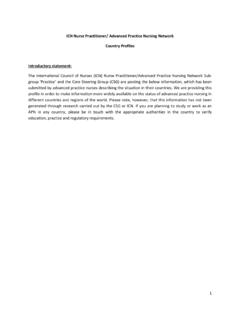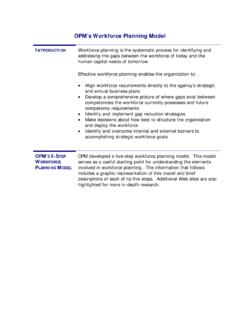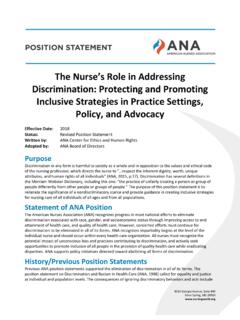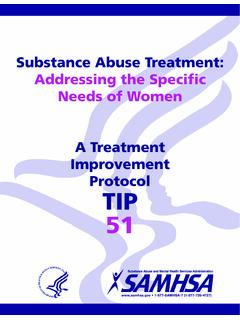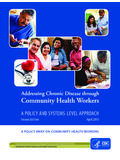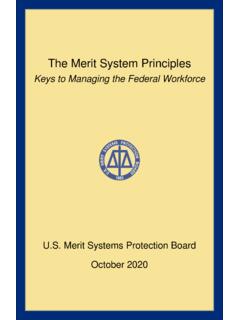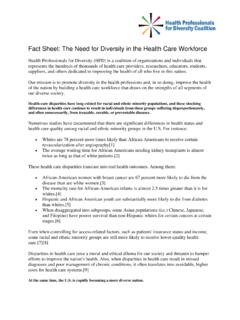Transcription of Addressing Issues Impacting Advanced Nursing Practice …
1 Addressing Issues Impacting AdvancedNursing Practice Worldwide^ m d AbstractAdvanced practicenursing roles aredevelopingglobally, andopportunities foradvanced practicenursing (APRN)are expandingworldwide due tothe need forexpert International APRN Role Development Ruth Kleinpell, PhD, RN, ACNP, FAANP, FAANA ndrew Scanlon, DNP, MN (Nurse Practitioner), MNS, RN, NP, FACN, FACNPD enise Hibbert, RGN, MSc, BSc, DipHE, ONC, STFreda DeKeyser Ganz, PhD, RNLinda East, PhD, RNDebbie Fraser, MN, RNC-NICF rances Kam Yuet Wong, PhD, RN, FAAN, FHKANM ichelle Beauchesne, DNSc, RN, CPNP, FAAN, FAANP, FNAPA dvanced Practice Nursing roles are developing globally, and opportunities for Advanced practicenursing are expanding worldwide due to the need for expert Nursing care at an Advanced level ofpractice. Yet it is well recognized that barriers exist with respect to APRNs being able to practiceto the full extent of their education and training.
2 Addressing barriers to APRN Practice worldwideand ensuring that APRNs are able to Practice to the full extent of their education and training canhelp to promote optimal role fulfillment as well as assessment of the impact of the APRN : Kleinpell, R., Scanlon, A., Hibbert, D., Ganz, F., East, L., Fraser, D., Wong, F., Beauchesne, M., (May31, 2014) " Addressing Issues Impacting Advanced Nursing Practice Worldwide" OJIN: The Online Journal ofIssues in Nursing Vol. 19, No. 2, Manuscript : words: Advanced Practice ; Advanced Practice Nursing ; Advanced Practice registered nurse; Advancednursing Practice ; international Advanced Practice nursingAdvanced Practice Nursing roles are developing globally, and opportunities foradvanced Practice Nursing (APRN) are expanding worldwide due to the need forexpert Nursing care at an Advanced level of Practice . APRN is a term used toencompass certified nurse midwife, certified registered nurse anesthetist,clinical nurse specialist, and nurse practitioner.
3 The International Council ofNursing defines an Advanced Practice nurse as a registered nurse who hasacquired the expert knowledge base, complex decision-making skills and clinicalcompetencies for expanded Practice , the characteristics of which are shaped bythe context and/or country in which s/he is credentialed to Practice (International Council of Nursing 2013). A master's degree is recommended forentry level, yet in some countries such as the United States, a clinical practicedoctorate is being recommended for APRN Practice (National Council of StateBoard of Nursing , 2008).Regulatory mechanisms and country specific Practice regulations underpin APRN Practice , yet it is wellacknowledged globally that APRN Practice encompasses several components including the ability to diagnose,prescribe medication, prescribe treatments, and perform and interpret diagnostic testing, among aspects ofadvanced Practice as outlined in Table Institute ofMedicine (IOM)report on thefuture of nursinghas highlightedthe importance ofpromoting theability of APRNsto Practice to thefull extent oftheir.
4 Specific countryregulations canimposerestrictions onvarious aspectsof APRN careincludinglegal/regulatorybarriers,in stitutionalbarriers andcultural barriers. The Institute of Medicine (IOM) report on the future of Nursing has highlightedthe importance of promoting the ability of APRNs to Practice to the full extent oftheir education and training and to identify further nurses contributions todelivering high-quality care (IOM, 2010). Yet it is well recognized that barriersexist with respect to APRNs being able to Practice to the full extent of theircapabilities. A number of challenges exist in regards to the increasing numbersof APRNs globally. These include poor role clarification, proliferation of APRN titles, differing educational requirements and degrees, scope of practiceconflicts, fragmentation/variability in standards and quality of educationalprograms (Schober & Affara, 2008; Hanson, 2013).
5 Table 1: Global Characteristics of the APRN RoleRight to diagnoseAuthority to prescribe medicationAuthority to prescribe treatmentAuthority to refer clients to other professionalsAuthority to admit patients to hospitalLegislation to confer and protect the title "Nurse Practitioner/ Advanced Practice Nurse"Legislation or some other form of regulatory mechanism specific to Advanced Practice nursesOfficially recognized titles for nurses working in Advanced Practice rolesAdapted from the International Council of Nursing , 2013In a survey assessing international trends of nurse practitioners- Advanced Practice nurses (NP-APNs)(Pulciniet. al, 2010), respondents from 31 countries identified a number of barriers related to NP-APN practiceincluding access to educational programs globally, lack of understanding of the NP-APN role, and lack ofrespect of the Nursing profession, among others as outlined in Table 2.
6 Variation in scope of Practice ,prescriptive authority and licensure requirements were also new report from IOM identifies that specific country regulations can imposerestrictions on various aspects of APRN care including legal/regulatory barriers,institutional barriers and cultural barriers. Specific examples include whetherAPRNs can admit patients, serve as primary care providers, sign orders forlong-term care services, be reimbursed for services, or be recognized by healthinsurance companies as providers or reimburse them directly (Robert WoodJohnson Foundation, 2013).Institutional and cultural barriers exist which can also impose barriers to APRN Practice . Specific examplesinclude healthcare institution s medical staff bylaws which restrict who can admit patients or perform certainprocedures, even if a qualified APRN is available. In many healthcare institutions, implementation of team-based, interprofessional collaboration is defeated by dated models of authoritarian leadership (Robert WoodJohnson Foundation, 2013).
7 While the degree to which regulatory/legal, institutional and cultural barriers canvary, common themes emerge when reviewing the status of APRN Practice in various 2: Global Challenges to the APRN RoleLimited access to educational programs Insufficient Nursing education Focus on the medical model NP Practice mustbe performedwith knowledge ofcurrent Australianhealthcaredeliverymechanisms aswell as Federal,State and localrequirements forpractice. Selected Country ProfilesBarriers to APRN Practice in theUnited States( ) includevariation amongthe 50 states withrespect to scopeof Practice ,prescriptiveauthority, andcollaborativepracticerequirements. Lack of understanding of the APRN role Lack of respect toward the Nursing profession Dominance of the medical profession Issues related to credentialingAdapted from Pulcini et al, 2010 United StatesBarriers to APRN Practice in the United States ( ) include variation among the 50 states with respect toscope of Practice , prescriptive authority, and collaborative Practice requirements.
8 Efforts to standardize theAPRN role have been underway since the endorsement of the APRN ConsensusModel which proposes uniformity in licensure, accreditation, certification andeducation in all 50 states by the year 2015 (National Council of State Boards ofNursing, 2008). In addition, the doctorate of nurse Practice (DNP) has beenidentified as the recommended educational preparation for APRN Practice . Whilenot required, the DNP is being proposed as the optimal education for ongoing initiatives to Addressing barriers to APRN Practice includeactive campaigns to bring public awareness and impact policy to removerestrictions to Practice (Brassard & Smolenski, 2011). Federal and state lawsand regulations as well as individual hospital and Practice site bylaws andpolicies can impact APRN Practice requirements. Addressing those that imposerestrictions to Practice is essential in order to promote uniformity in APRN Practice among the 50 states.
9 National organizations have acknowledgedthe importance of removing barriers to APRN Practice , citing that removingbarriers to care reduces costs of care, increases patient s choice, and improveshealthcare quality (American Association of Nurse Practitioners, 2012).AustraliaWith the enactment of the 2009 Health Practitioner Regulation National Law Act in July 2010, Australia s sixstates and two territory boards of Nursing became one unified national board and with it a national nursepractitioner endorsement process. This move to a national board with national standards was not withoutdifficulty or controversy (Scanlon, Cashin, Watson, & Byrce, 2012), but these initial implementation barriershave been somewhat overcome. Currently the requirements for nurse practitioner endorsement withinAustralia include: compliance with the Nurse Practitioner standards for Practice ( Nursing and Midwifery Board ofAustralia, 2014); an unrestricted registration as a registered nurse; 5000 hours experience at an advancednursing Practice level within the previous six years ( Nursing and Midwifery Board of Australia, 2013);completion of an approved nurse practitioner program of study at Master s level or equivalent; as well ascompliance with national standards for recency of Practice and additional continuing professional development( Nursing and Midwifery Board of Australia, 2011; 2012).
10 However, having a national process for NP endorsement does not mean there isa singular legislative or regulatory process that governs all NP practicethroughout Australia. On the contrary, there are additional layers of Federal,State and Territory legislative and regulatory requirements related tohealthcare provider reimbursement or medication prescription subsidy from theAustralian government s universal healthcare system. Additionally, there aregovernance processes and authorization practices and protocols of individualhealthcare organizations or networks all of which must comply with the NationalFramework for the Development of Decision-Making Tools for Nursing andMidwifery Practice (Australian Nursing and Midwifery Council, 2007). Theseadditional requirements to Practice appear to be at times contradictory tofederal legislation, NPs training, experience, competency, authorization, orpublic need and have no clear rationale or uniformity from jurisdiction tojurisdiction or for other healthcare professionals practicing at similar levelsand/or similar populations.


